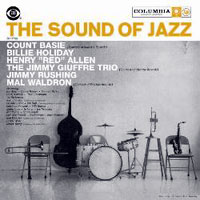The Sound of Jazz
While this number steals the show, no matter how hard you look, you won't find it in the album notes, which is a shame. It would have been yet another reason to recommend this all-star session. What we'd call bop was considered modern, almost avant-garde, in 1957, "Blue Monk" and Mal Waldron's solo piece "Nervous" breaking up the swing- and Dixieland-dominated program. Billie Holiday twists and turns her way through "Fine and Mellow," for which she reunited with Lester Young. Both would be dead in less than two years. Rushing showed great presence on a percolating blues number, "I Left My Baby," backed by Basie, Young, Hawkins and Eldridge. There are stretches within the many Norman Granz Jam Session recordings during which it's apparent that the collection of musicians thrust together just doesn't gel. Even with the big-time talent and celebrity on display for "The Sound of Jazz," the session moves along briskly, not one number sounding labored or perfunctory. If, as Michael Fremer recently divulged, Columbia Records switched to the RIAA curve in the mid-1950s, they did themselves no favor by not indicating this somewhere on the album jackets, as other labels did. And in this debate, there is also the generally thin and wiry sound of so many Columbia recordings made in the '50s, including this one, to consider. Even if the Columbia curve was not used here, the original pressing still sounds better played with it, and the reissue, which uses the RIAA curve, sounds both utterly different and better -- fuller, weightier in the bass and more balanced overall. As is always the case with Pure Pleasure LPs, which are pressed at Pallas in Germany, this one is as quiet as present-day vinyl gets. This isn't a particularly collectible mono jazz title --
originals are easy to find for a few dollars. The session was also recorded in stereo, and
that version is slightly more difficult to find and has better-than-average two-channel
sound for 1957 -- music actually happens in between the right and left speakers.
I'm not one to carp about mono -- I listen nearly as often in 1.0 as 2.0 -- but the choice
of mono here is curious, unless the stereo tapes are no longer available or not in usable
condition. No matter -- this is still an important set from one of jazz's early days in
the sun. |

 he Sound of Jazz"
was an episode of CBS's The Seven Lively Arts, an hour-long arts and entertainment
series that aired live on Sunday afternoons, in this case Sunday, December 8, 1957.
Critics Nat Hentoff and Whitney Balliett organized the show, which highlighted modern jazz
and featured a veritable dream team of musicians, including Count Basie, Billie Holiday,
Jimmy Rushing, Coleman Hawkins, Ben Webster, Lester Young, Gerry Mulligan, Jimmy Giuffre,
Pee Wee Russell, Jo Jones and Roy Eldridge. Three days before the episode aired, CBS
recorded the various ensembles at a rehearsal, and that recording became this album.
Thelonious Monk was scheduled to perform with bassist Ahmed Abdul-Malik and drummer Osie
Johnson, but worry over the performance caused him to miss the taping. Mal Waldron
replaced him, in addition to accompanying Billie Holiday. Monk did make it to the Town
Theater for the TV show itself,
he Sound of Jazz"
was an episode of CBS's The Seven Lively Arts, an hour-long arts and entertainment
series that aired live on Sunday afternoons, in this case Sunday, December 8, 1957.
Critics Nat Hentoff and Whitney Balliett organized the show, which highlighted modern jazz
and featured a veritable dream team of musicians, including Count Basie, Billie Holiday,
Jimmy Rushing, Coleman Hawkins, Ben Webster, Lester Young, Gerry Mulligan, Jimmy Giuffre,
Pee Wee Russell, Jo Jones and Roy Eldridge. Three days before the episode aired, CBS
recorded the various ensembles at a rehearsal, and that recording became this album.
Thelonious Monk was scheduled to perform with bassist Ahmed Abdul-Malik and drummer Osie
Johnson, but worry over the performance caused him to miss the taping. Mal Waldron
replaced him, in addition to accompanying Billie Holiday. Monk did make it to the Town
Theater for the TV show itself,